|
Some contractors price construction projects, yet they’ve never seen the project site before submitting their proposal. This can be dangerous unless the RFP (Request for Proposal) document is very clear as to the specific site conditions, including the neighbouring properties. I know it’s possible to view much data on the internet, including aerial views and even the underlying geology. However, to really get the full appreciation of potential problems nothing beats actually visiting and walking the project site before pricing the construction project – kicking the dirt and literally feeling the project conditions. You don’t want to be awarded a project and the first day you arrive to find there’s a low level suspended power cable across the entrance road, or that the local authorities are digging up the road and access to the property is blocked, or the project site is steeply sloping, jammed in between neighbouring high-rise buildings and the site was an old landfill. Damaging existing services The project site conditions often dictate the construction methods and the types of equipment that can be used and it will determine the construction schedule. Of course visiting the project site often also provides an opportunity to meet the client or their team. Meeting those involved with the construction project enables relationships to form and provides a sense of who they are and what’s important to them. In construction it’s important to know your clients. It could save you. We once sent a young engineer to attend a site inspection for a project we were pricing. When we came to review our price we called the engineer in to explain to us what the project site looked like. It was frustrating as they couldn’t provide any useful information about the site. I was quite annoyed, but in hindsight, we should have given them a better briefing and explained what to look for and note during the site visit. "You are the eyes and the ears of the estimator. It's important to accurately convey everything you see and hear." When someone, other than the estimator, attends a site inspection, it’s important that they remember that they are acting as the eyes and ears of the person formulating the price and they need to note as much useful information about the project site and its immediate area as possible. The quality of the information provided could substantially influence the way the RFP is completed and may end up helping to win the project, or contribute to losing it. Potential problems which are missed during the site inspection could later be costly to the company because they weren’t taken into account when formulating the price or in preparing the construction schedule. When inspecting a site it is important to remember that first impressions count. Clients won’t be impressed with contractors that are sloppily dressed, or that arrive late for the meeting. Of course, it doesn’t mean you have to be dressed in a suit either, in fact, suits can put some people off. Come prepared with a notebook, camera, and tape measure. Always ask permission before taking pictures. Some projects require personal protective equipment to be worn, so confirm what’s required before setting out for the meeting. Before visiting the project read through the pricing documents and information so there is an understanding of the project scope of work. Note questions to raise with the client and points to be specifically looked at on the visit. #constructionestimation #constructionestimates #constructionprofessionals What to check when visiting the project siteDuring the visit note the following for us in your proposal:
Check the area around the construction projectAfter visiting the project site explore the surrounding area and check for: 1. Possible suppliers and contractors, noting their size, equipment, facilities and contact details. 2. The general safety of the area – projects in high crime areas can mean that extra project security is required and employees may be reluctant to work on the project. 3. The general neighbourhood. Is it quiet, is it busy? Are the roads congested. Prepare a brief report on the visit, including all relevant information and photographs, and submit this to the estimating team. The winning edge for pricing your construction projectsVisiting a project site before formulating your price can provide much valuable information, information which will help to avoid expensive mistakes, information that can provide insights into the project that will give the company a winning edge. Visiting the project site also provides the opportunity to start building a relationship with the client. If the contractor appears knowledgeable and well informed it will give the client comfort that the company can do the job. Some contractors get a good feeling, or pick up a bad vibe, when they visit a project site. Call it intuition or a sixth sense! But it’s often more than this, walking the project, kicking the dirt, talking to the client, provides a sense of project conditions and future working relationships. Sometimes savvy contractors can almost smell trouble in the air! Have you submitted a price without visiting the project site, only to uncover an unpleasant surprise after landing the project? #pricingconstructionprojects #constructionprojectmanagement #contractors This article was first published on the ClockShark website. Please share this post © 2017 This article is not to be reproduced for commercial purposes without written permission from the author. Other useful articles Your tender submission or quotation – Get it right Don’t make a mistake when you price your next construction project Asking questions in the bidding process Do you want to learn how to manage construction projects successfully"I highly recommend this book be read by all newly qualified construction project managers as well as those more experienced." (Reader 1 - Amazon.co.uk) To read more about the author’s books and find out where you can purchase them visit the pages on this website by clicking the links below:
'Successful Construction Project Management: The Practical Guide' 'Building a Successful Construction Company: The Practical Guide' 'Construction Claims: A Short Guide for Contractors' 'Construction Project Management: Tips and Insights' 'Construction Management: From Project Concept to Completion' 'Construction Book reviews' To read more about the author visit the page 'Paul Netscher' Want to contact Paul Netscher please enter your details on 'Contacts' Find out how Paul Netscher can help you Order your books from Amazon Order your books from Amazon UK
0 Comments
The number of project scheduling and planning terms out there can be overwhelming. Interpreting and communicating a plan can become a task in itself if you are not up-to-date with the planning jargon. So here is a list of 70 Project Scheduling terms every planner should know for smooth sailing – check out the glossary below to brush up on your terms.
.....Continue Reading......  Image courtesy of David Castillo Dominici at FreeDigitalPhotos.net Image courtesy of David Castillo Dominici at FreeDigitalPhotos.net Construction projects employ people from diverse cultures and educational and economic backgrounds. Working in this environment can be challenging, but interesting. It's easy to pigeonhole people according to who they are, or where they come from. "They are from x country so they must be bricklayers". "He comes from z country so he's a scaffolder". “They are dressed poorly so they aren’t educated.” These days more women are entering the industry and they often face problems getting employment in some jobs. Sometimes there are all kinds of excuses why women shouldn’t be employed on construction projects. I came from a country where people of a certain colour were discriminated against and were unable to fill some positions on our construction projects. These laws even restricted where they could live and work. This was the law in the country. Their colour limited the education they could get. Of course this meant we had to import people (of the “right colour”) from other countries to do the work. Even when the laws were repealed we still faced skill shortages because the majority of the population suffered from poor education. But, sometimes even today in many countries people are discriminated against because of their colour or ethnicity. In some countries people are even discriminated against because of their religion. Why should your personal religious choices impact what job you can or can't do if it doesn't impact on your work ethic and quality? But discrimination also works the other way, where particular individuals are favoured, promoted, or paid larger salaries, because they speak the right language, maybe even say the ‘right’ things, or are simply friends of the boss. Nepotism is a form of discrimination. We all take our preconceptions with us. The way we were brought up, the environment we grew up in, our past experiences, and of course the people we associate with all contribute to the way we act and operate. We are all guilty of being racist to some degree. We often talk about people in terms of their nationality, country of origin, gender, colour or ethnicity. We even focus on the way people dress. Sure being dressed appropriately does show respect. But how many of you would offer a homeless person a job, if they walked onto your project dressed in dirty torn clothes. There are even some who won’t offer a person a job because they have weird hairstyles or tattoos. Indeed, I was surprised to hear a few years back that the fact that I have a beard was seen as a reason not to promote me – there I thought it was for other reasons! It’s when we favour one person over another because of their backgrounds, appearance, colour, gender or nationality, rather than their skills and experience that it is really harmful. When we make judgement calls based on our perceptions of the person’s ability which are based purely on their appearance, rather on their actions, qualification and experience. When we pigeonhole somebody based on our expectations of that person because of their background and ethnicity, rather than finding out more about how they can contribute to our projects and company. What are the risks of discrimination? Construction is crying out for good people. We never seem to have sufficient skilled people. We need all the good people we can get, and can't afford to discriminate against someone because of their race, culture, religion, appearance, gender or colour. We need the best people working for us, we need the best people filling the top positions. We can’t afford to employ incompetent people. We cannot afford to ignore a sizable chunk of the population based solely on our preconceptions (or someone else’s ideas) of their abilities. But we also need to focus our training on the best people, those who are willing to learn, those who want to achieve more, those that can play an important role on our projects, and more importantly on our future projects – irrespective of their identity. Providing opportunities to a person who might not receive the same breaks elsewhere can often engender loyalty and gratefulness which more than repays the company’s investment in that person – indeed, the company was usually amply rewarded by those that I provided opportunities to for advancement. Putting a person in a particular box or group, or labelling them according to our preconceived notions of where they should go and what they can or can’t do, stifles innovation. But it is also hurtful to people and it demotivates them. Elevating or promoting a person on reasons which aren’t based on their skills and experience alone means we don’t have the best person doing the job. We possibly have the wrong person doing the job who is even going to harm our projects and company. But, it also often creates a sense of entitlement. People who know that they’ll advance based purely on their colour, or who they know, often become lazy, because they know they don’t have to strive to prove themselves. Fortunately, in many countries discrimination is frowned upon, even a criminal offense. Companies that are guilty of discriminatory practices could encounter bad publicity, the wrath of the public and even sizable monetary fines. Unfortunately, those companies found-out with discriminatory behaviours often swing to the other extreme, where people are promoted from the group that was previously discriminated against, based purely on their colour and ethnicity. Indeed, discrimination hasn’t been done away with but merely reversed in a knee-jerk reaction to pacify complainants. Language becomes so restrictive so as not to offend someone that things that should be said aren’t said. People that aren’t performing aren’t disciplined in case it’s seen as being discriminatory or racist. But, a company that treats all employees equally based only on their knowledge, experience and work ethic, and where their employees understand this and trust management, usually don’t have to fear being accused of racist behaviours and can engage in open, honest and even robust communication with all employees. Companies that are training and providing opportunities to all employees equally, based on their work ethic and commitment, irrespective of their background, will find that with time their senior management will be representative of their workforce and of the general population. There will be no need to promote someone who isn’t capable for the sole reason that it satisfies demands for management to be more representative. Given opportunities and training good people will naturally rise to senior management positions. Of course, often a sizable percentage of clients are also supposedly of the “wrong” gender, colour, ethnicity, class, background or religion. Those that discriminate and won’t work for these people are severely cutting their market place. But, most discriminatory people are hypocritical and are happy to practice discrimination only when it suites them. Nevertheless, many customers see through this pretence. After all, if someone engages in discriminatory practices every day in the workplace they’ll often find it difficult to hide their disdain for a person from the 'wrong' grouping or someone they don’t approve of, even if that person is now their client. A company that has management dominated by individuals from a particular group (colour, gender, language, ethnicity) in a multicultural society probably practices discrimination, even if they say otherwise. Can a client expect to be treated fairly if the company isn’t treating their own employees fairly? Ignoring discrimination Maybe we aren’t directly guilty of discrimination, but there are others on our projects who discriminate against individuals, who favour some over others, that make lewd, or racist comments, or even tell inappropriate jokes which could offend others in the work place. Turning a blind eye to these behaviours on our projects is as bad as if the comments or actions came directly from us. People who are offended by these remarks become distracted, even demotivated. It is a cause for conflict. In some cases, it can even lead to people leaving the company, and in the extreme case even suicide. But, people who make these inappropriate comments could even go further with there discriminatory ways, ignoring the best person for promotion because of their colour or gender. Ignoring, discriminatory remarks and behaviours often emboldens the individuals to discriminate further. We need to stand up to discriminatory behaviour. Conclusion It is easy to discriminate against individuals. Often, we do it subconsciously without even knowing it. We base our opinions and choices on our perceptions rather than facts. Unfortunately, there are also many who actively pursue discriminatory practices. But, doing so means that our projects will suffer, we won’t necessarily be employing the best person, we won’t be promoting the best people, we may be offending potential clients, we’re not fostering unity and team work on our projects, employees will become demotivated, some employees will leave in frustration, while those who are favoured often become slack knowing that they are protected because of who they know, or because of their skin colour. We live in multicultural and multi-talented societies. Construction everywhere faces a dearth of good, experienced and skilled people. We cannot afford to reject someone, or favour another, based purely on our perceptions or our personal likes. Next time that poorly dressed homeless person comes to your project looking for work, take the time to find out what their skills and experience is, who knows what gem may be hidden under that untidy experience. Don’t automatically judge a person by their outward appearance. But equally, ensure that those working with you are as committed as you are to fostering a workplace that is non-discriminatory, a harmonious workplace, with equal opportunities for everyone. Everyone deserves an equal chance. How has discrimination in the workplace impacted you? Are there discriminatory practices on your projects? This article is adapted from information in the author’s popular books: 'Successful Construction Project Management: The Practical Guide' and 'Building a Successful Construction Company: The Practical Guide' and 'Construction Project Management: Tips and Insights'
'Construction Claims: A Short Guide for Contractors' is another of Paul's useful books. Paul has recently published 'Construction Management: From Project Concept to completion'. These books are available on Amazon and other online book stores. Paul publishes articles regularly on LinkedIn and his website. Paul writes regular articles for other websites, gives lectures, mentors, and is available for podcasts and interviews. © 2018 This article is not to be reproduced for commercial purposes without written permission from the author. Construction projects are usually done in a rush. Contractors are so focused on completing their work in the shortest time that they often make simple mistakes – mistakes that can be costly, and mistakes that could often have been avoided if the person had taken a few extra minutes to stop and ask these questions. These questions are the key to being a better contractor.
Take a little extra time to ask these questions and your project will be completed safely, quicker, more productively and quicker. This article was first published on the ClockShark website. Please share this post Do you want to learn how to manage construction projects successfully""Excellent writing, very useful and all around good read" (Reader on Amazon) To read more about the author’s books and find out where you can purchase them visit the pages on this website by clicking the links below:
'Successful Construction Project Management: The Practical Guide' 'Building a Successful Construction Company: The Practical Guide' 'Construction Claims: A Short Guide for Contractors' 'Construction Project Management: Tips and Insights' 'Construction Management: From Project Concept to Completion' 'Construction Book reviews' To read more about the author visit the page 'Paul Netscher' Want to contact Paul Netscher please enter your details on 'Contacts' Find out how Paul Netscher can help you Order your books from Amazon Order your books from Amazon UK © 2017 This article is not to be reproduced for commercial purposes without written permission from the author. The other day I was on a cruise ship. I noticed a flock of pigeons flying around the ship. This was strange as we were several miles from the nearest land – after all, pigeons are land birds, they aren’t seagulls! They had probably joined the ship at our last port. The pigeons landed on the ship but were continually disturbed by crew and passengers and forced into the air. This went on for hours during the day. The ship got further away from land, but it remained visible on the horizon. We passed other ships, some close and others further away, some heading in the same direction and others going back the way we had come. Yet the pigeons stuck with us. They became more tired as the day wore on having to continue flying. There was no fresh water for them to drink. Some eventually fell into the sea, left to drown. Those that remained with the ship were going to a land they didn’t know. A land far from their mates. If only the pigeons had lifted their heads to the horizon they would have seen land. They could easily have flown to safer ground where they had a chance of finding food and fresh water and a safe place to rest their weary wings. Even flying to a passing ship may have given them a quieter place to rest, possibly even a pool of rainwater trapped in a container to drink. If they had cognitive thought they could have picked a ship heading in the direction they had come from so they could have returned home. Every hour was taking them further from home. Unfortunately, in construction, the same often happens. Construction company owners are often so focussed on the immediate survival of their company, dealing with the day to day problems on their projects, that they don’t lift their heads to see the opportunities that are passing them by. They are sailing a path without a clue as to where it will take them, or what storms will buffet them along the way. They have no idea where they’ll find finances, resources, or the next project. (Really like the pigeons who didn’t know where they were going, were becoming more exhausted and didn’t have food or water!) Many companies follow the path they are on, often following other contractors – like a flock of pigeons. Eventually, these contractors will drown when they run out of work or finances. But, smart contractors take the time to look further than their next project. They look for other opportunities on the horizon, other projects. They have a vision for the future and aren’t just blindly following the first ship that they jumped on. This vision is changing depending on circumstances and events around them. They see other opportunities around them, investigate them, and take those that are suitable. It’s vital for contractors to have good intelligence. To spot the next project, the next potential client, the next developing market. Markets change, clients come and go, so it’s important that contractors are adaptable, otherwise, they’re going to become stuck in a direction which could eventually sink them. Clients that were once reliable sources of work may eventually run out of work (no longer be expanding, need to cut back on their costs, or even close down), or they may give their work to another contractor. Markets that were niche, with little competition, can quickly become flooded with competitors. Construction methods are evolving and smarter contractors can deliver a better product cheaper and faster. Contractors need to be aware of what’s happening around them, noticing what their competitors are doing, what their clients are doing, what the new innovations are in construction, even what their employees are doing. The world is changing. The way we have always done business in the past will not be the way to do business in the future. What worked yesterday is probably not the best solution today, and will almost definitely not be the right solution in the future. ....Continue Reading.... This article was first published on the ClockShark website. To visit this website and continue reading the article click on the link above.
Please share this post To read more about the author’s books and find out where you can purchase them visit the pages on this website by clicking the links below: 'Successful Construction Project Management: The Practical Guide' 'Building a Successful Construction Company: The Practical Guide' 'Construction Claims: A Short Guide for Contractors' 'Construction Project Management: Tips and Insights' 'Construction Management: From Project Concept to Completion' 'Construction Book reviews' To read more about the author visit the page 'Paul Netscher' Want to contact Paul Netscher please enter your details on 'Contacts' Find out how Paul Netscher can help you Order your books from Amazon Order your books from Amazon UK © 2017 This article is not to be reproduced for commercial purposes without written permission from the author. This is an interesting article that everyone involved in the Construction Industry should read.
Construction will change, indeed it is imperative that it does. Those that don't change will be left behind. Read Imagining Constructions Digital Future Unfortunately this article doesn't address the important issue of training for the future. It also doesn't mention that despite incorporating new technology construction will always need skilled and experienced project managers. I’m sure we’ve all attended many project kickoff meetings. Mostly these were boring, generic and we’ve barely taken any notice of what was been said. Somewhat like listening to the safety briefing on an aeroplane, just before take-off – you’ve heard it all before. But just as listening to the safety briefing on the aeroplane could be the difference between you surviving an air crash or not, so to could that project safety meeting be the difference between life and death. Some aircrews try and spice up the safety briefing by adding a few quirks and jokes. But even these can become boring for regular flyers. Most construction projects delegate the safety advisor to present the project induction. Often these are done as a ‘tick and flick’ exercise, which consists of reading a list of ‘do’s and don’ts’ and signing the bottom of the piece of paper. Site kickoff meetings should be more than only focussing on generic safety issues. They are an opportunity to welcome new workers, explain what they’ll be doing on the project, and give them an understanding of where they’ll be working and how they’ll fit into the contractor’s organisational structure. It’s an opportunity to discuss project rules, ensure new workers understand the quality requirements and know what’s expected of them, and of course, it’s vital to highlight specific safety issues that will be encountered on the project. What to include in project kick-off meetingsI generally include the following in project inductions:
This article was first published on the ClockShark website. To visit this website and continue reading the article click on the link above.
Please share this post To read more about the author’s books and find out where you can purchase them visit the pages on this website by clicking the links below: 'Successful Construction Project Management: The Practical Guide' 'Building a Successful Construction Company: The Practical Guide' 'Construction Claims: A Short Guide for Contractors' 'Construction Project Management: Tips and Insights' 'Construction Management: From Project Concept to Completion' 'Construction Book reviews' To read more about the author visit the page 'Paul Netscher' Want to contact Paul Netscher please enter your details on 'Contacts' Find out how Paul Netscher can help you Order your books from Amazon Order your books from Amazon UK © 2017 This article is not to be reproduced for commercial purposes without written permission from the author.  Image courtesy of Stuart Miles at FreeDigitalPhotos.net Image courtesy of Stuart Miles at FreeDigitalPhotos.net Wow, what happened to 2017? It seems just the other day that we started 2017, now it’s all gone. How was 2017 for you? For some it was a disaster, many were disappointed, most it was ok, and a few had a terrific 2017. What will 2018 bring for you? I’m sure most of you have had a hectic few weeks, rushing to finish off the last work for the year, then Christmas, parties, time with friends and family, the New Year, now it’s back to work! Have you had any time for yourself? Before you know it you’ll be well into 2018, then all too soon you’ll be starting 2019. Pause for a few minutes. Take some time out. Take a deep breath. Make some time for you. Consider these thoughts before 2018 swamps you.
Don’t look back on 2018 with regrets. Take some time out to plan 2018, then remember to make time during 2018 to measure progress of your plan. Don’t let the trials and tribulations of 2018 drown your good intentions and your aspirations. What will you do to make 2018 successful? Wishing you a happy and successful 2018. Thank you to all my readers for your support in 2017. You made 2017 a great year for me. This article is adapted from information in the author’s popular books: 'Successful Construction Project Management: The Practical Guide' and 'Building a Successful Construction Company: The Practical Guide' and 'Construction Project Management: Tips and Insights'
'Construction Claims: A Short Guide for Contractors' is another of Paul's useful books. Paul has recently published 'Construction Management: From Project Concept to completion'. These books are available on Amazon and other online book stores. Paul publishes articles regularly on LinkedIn and his website. Paul writes regular articles for other websites, gives lectures, mentors, and is available for podcasts and interviews. © 2018 This article is not to be reproduced for commercial purposes without written permission from the author. Often contractors rush into a project without considering and choosing the most appropriate construction method or the sequencing of the tasks. Sometimes customers specify a construction methodology or the estimator proposed a methodology when they submitted the price to the customer. But are these the best and most efficient methodologies? In fact, when the construction team looks at the project they could find that the suggested methods aren’t appropriate. I’ve often used alternative methods of construction which have been quicker and more efficient than those proposed, resulting in reduced costs. However, it should be noted that usually, the customer needs to be informed if the contractor selects a different construction methodology to the one specified in the request to price documents or the one the contractor proposed in their price submission. In particular, if the contractor decides on using different materials these will have to be approved by the customer. There’s normally more than one method that a project can be constructed, but often some methods will be safer and more efficient than others. Time spent understanding the project and the site conditions as well as the available resources and their capabilities and then analyzing the suitability of different construction methodologies will result in the best construction method being selected which is appropriate for the project, and which can deliver the project efficiently, safely and within the specified time. Methodologies that worked on another project may not be the best for the next project. What to consider when deciding on a construction methodology Some factors to consider when deciding on the construction methods are:
This article was first published on the ClockShark website. To visit this website and continue reading the article click on the link above.
Please share this post To read more about the author’s books and find out where you can purchase them visit the pages on this website by clicking the links below: 'Successful Construction Project Management: The Practical Guide' 'Building a Successful Construction Company: The Practical Guide' 'Construction Claims: A Short Guide for Contractors' 'Construction Project Management: Tips and Insights' 'Construction Management: From Project Concept to Completion' 'Construction Book reviews' To read more about the author visit the page 'Paul Netscher' Want to contact Paul Netscher please enter your details on 'Contacts' Find out how Paul Netscher can help you Order your books from Amazon Order your books from Amazon UK © 2017 This article is not to be reproduced for commercial purposes without written permission from the author. |
Archives
June 2024
Note: We welcome genuine comments, especially comments that add additional information to the subject matter in the article. We however reserve the right to remove inappropriate comments, which includes comments that have nothing to do with the subject, comments that include inappropriate language, and comments that are an advertisement for a product or company, or which include an advertising link. Comments must be in English. We will not enter into discussion on why a particular comment was removed.
CategoriesCopyright 2016 - The attached articles cannot be reproduced for commercial purposes without the consent of the author.
The opinions expressed in the attached articles are those of the writer. It should be noted that projects are varied and different laws and restrictions apply which depend on the location of the contractor and the project. It's important that the reader uses the supplied information taking cognisance of their particular circumstances. The writer assumes no responsibility or liability for any loss of any kind arising from the reader using the information or advice contained herein. "I have what I consider some of the best books on construction management."
Books are available from: Amazon.com Amazon.co.uk takealot.com kalahari.com Amazon.in Amazon.de Amazon.fr Amazon.it Amazon.com.au Powell's Fishpond uread bokus Amazon.ca Amazon.es Other retail stores Available in paperback or on Kindle "28 YEARS OF CONSTRUCTION PROJECT MANAGEMENT EXPERIENCE, DEVELOPING SUCCESSFUL CONSTRUCTION PROJECT MANAGERS AND BUILDING SUCCESSFUL CONSTRUCTION COMPANIES"
|

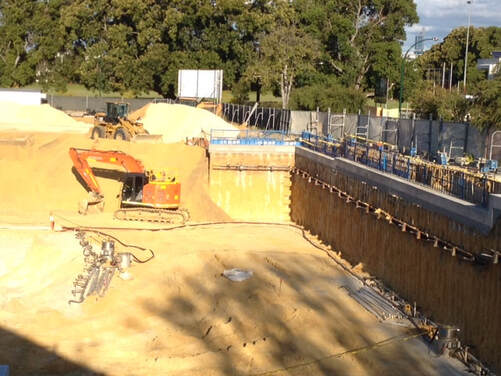
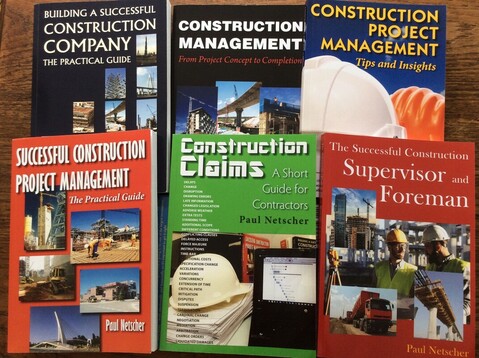

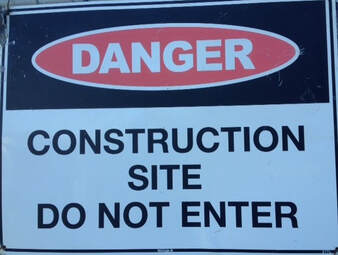
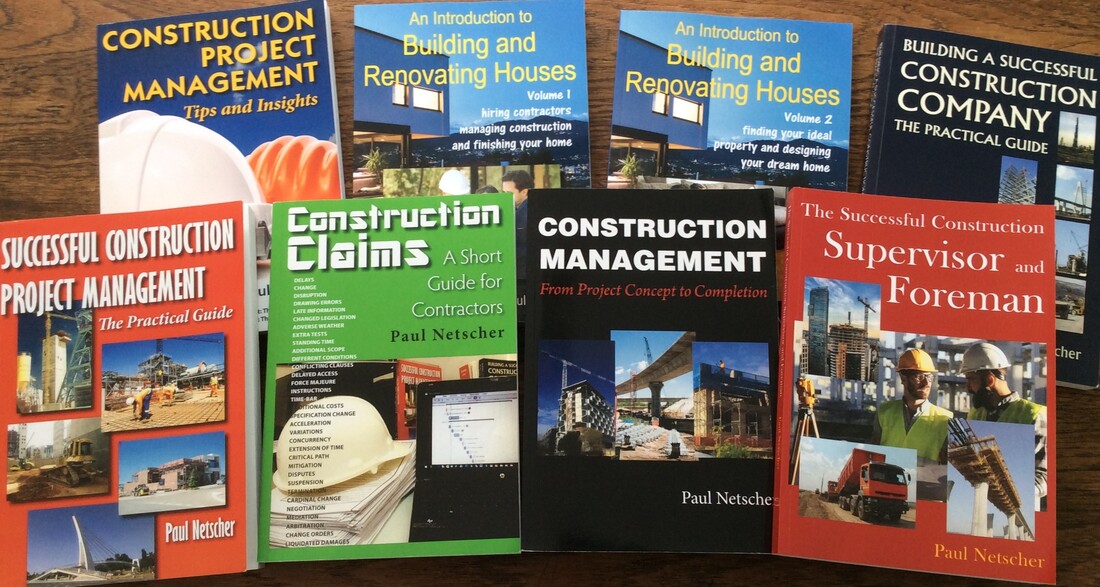

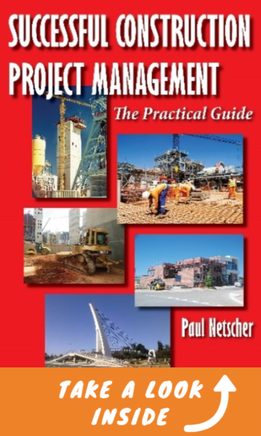


 RSS Feed
RSS Feed




